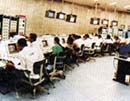In the new state-of-the-art propellant, the fuel which burned was a liquid polymer, but this formed only 13 per cent of the total weight. The rest was solid, comprising aluminium powder and ammonium per-chlorate, which supplied oxygen while burning. These materials had to be developed and then mixed into a uniform slurry which could be cast into blocks. Gowarikar’s team took four years to develop the propellant. A manufacturing facility for ammonium per-chlorate was established at Alwaye in Kerala. Later, another state-of-the-art solid propellant, hydroxyl-terminated poly butadiene was developed, giving ISRO a world-class capability in solid propellants.
Side by side with the launch vehicle programme, in the late sixties, Sarabhai was also thinking about starting a satellite systems division. He gave this responsibility to U R Rao, one of his students at PRL. Rao later became chairman of ISRO. His aim was to start with a small technological satellite, then experimental remote sensing and communication satellites, and the finally the operational satellites.
These became the Aryabhata (the technological satellite), Bhaskara I & II (experimental remote sensing satellites), the Apple (experimental communication satellite) and the Insat and IRS series. ISRO got free launches from the Soviet Union and France (Apple) for the first four satellites. Before Sarabhai died in 1971, conceptual thinking had gone into virtually all the satellites ISRO has launched so far.
His death, however, came at a crucial juncture, Design on SLV-3 had just begun. He had started talking to the Russians for the launch of Aryabhata, but the deal was not finalised. Sarabhai had also initiated work on another major project: the Satellite Instruction Television Experiment which later became a major social experiment. After Sarabhai died, M G K Menon took over the chairmanship of the Atomic Energy Commission (Space was still part of it). But this was a temporary measure; someone had to be found just for the space programme. The government’s choice was Satish Dhawan, then director of IISc in Bangalore.
 There was one problem, however: Dhawan wasn’t willing. “I did not want to leave the institute,’' says Dhawan. “I went to see the prime minister and the governing council, and said that I was not leaving the institute.” So Dhawan was allowed to stay on and run the space programme from Bangalore. A separate department of space was formed in 1972, with a space commission to formulate policies and ISRO to execute them. Dhawan became the first chairman of ISRO.
There was one problem, however: Dhawan wasn’t willing. “I did not want to leave the institute,’' says Dhawan. “I went to see the prime minister and the governing council, and said that I was not leaving the institute.” So Dhawan was allowed to stay on and run the space programme from Bangalore. A separate department of space was formed in 1972, with a space commission to formulate policies and ISRO to execute them. Dhawan became the first chairman of ISRO.
Under Dhawan, Sarabhai’s vision crystallised into a series of missions. The space programme had grown fast in the preceding years, and ISRO had a staff strength of 3,000, most of the scientists working in small technology projects initiated by Sarabhai. ‘'But the goals of all these people," says Dhawan, “didn’t necessarily fit into the ISRO mission. For that purpose it needed some structure.”
So Ahmedabad became the Space Applications Centre. The Space Science & Technology Centre and TERLS at Thiruvananthapuram came together as the Vikram Sarabhai Space Centre. A big rocket launch facility (36,000 acres) had already been created at Sriharikota, an island near Madras, and this became the Sriharikota Range.
Kind courtesy: BusinessWorld
Tell us what you think of this feature



